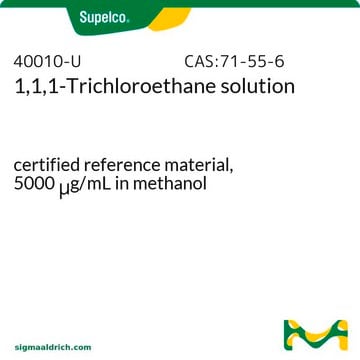235571
1,1,1-Trichloroethane
ReagentPlus®, ≥99%, contains 0.05% low alkyl epoxide as stabilizer
Sinónimos:
Methylchloroform, ‘Chlorothene’
About This Item
Productos recomendados
densidad de vapor
4.6 (vs air)
presión de vapor
100 mmHg ( 20 °C)
Línea del producto
ReagentPlus®
Ensayo
≥99%
temp. de autoignición
998 °F
contiene
0.05% low alkyl epoxide as stabilizer
lim. expl.
7.5-15 %, 25 °F
índice de refracción
n20/D 1.4366 (lit.)
bp
74-76 °C (lit.)
mp
−35 °C (lit.)
densidad
1.336 g/mL at 20 °C (lit.)
cadena SMILES
CC(Cl)(Cl)Cl
InChI
1S/C2H3Cl3/c1-2(3,4)5/h1H3
Clave InChI
UOCLXMDMGBRAIB-UHFFFAOYSA-N
¿Está buscando productos similares? Visita Guía de comparación de productos
Aplicación
Información legal
Palabra de señalización
Warning
Frases de peligro
Consejos de prudencia
Clasificaciones de peligro
Acute Tox. 4 Inhalation - Eye Irrit. 2 - Ozone 1 - Skin Irrit. 2
Código de clase de almacenamiento
6.1C - Combustible acute toxic Cat.3 / toxic compounds or compounds which causing chronic effects
Clase de riesgo para el agua (WGK)
WGK 3
Punto de inflamabilidad (°F)
Not applicable
Punto de inflamabilidad (°C)
Not applicable
Equipo de protección personal
Eyeshields, Faceshields, Gloves, type ABEK (EN14387) respirator filter
Elija entre una de las versiones más recientes:
¿Ya tiene este producto?
Encuentre la documentación para los productos que ha comprado recientemente en la Biblioteca de documentos.
Nuestro equipo de científicos tiene experiencia en todas las áreas de investigación: Ciencias de la vida, Ciencia de los materiales, Síntesis química, Cromatografía, Analítica y muchas otras.
Póngase en contacto con el Servicio técnico









